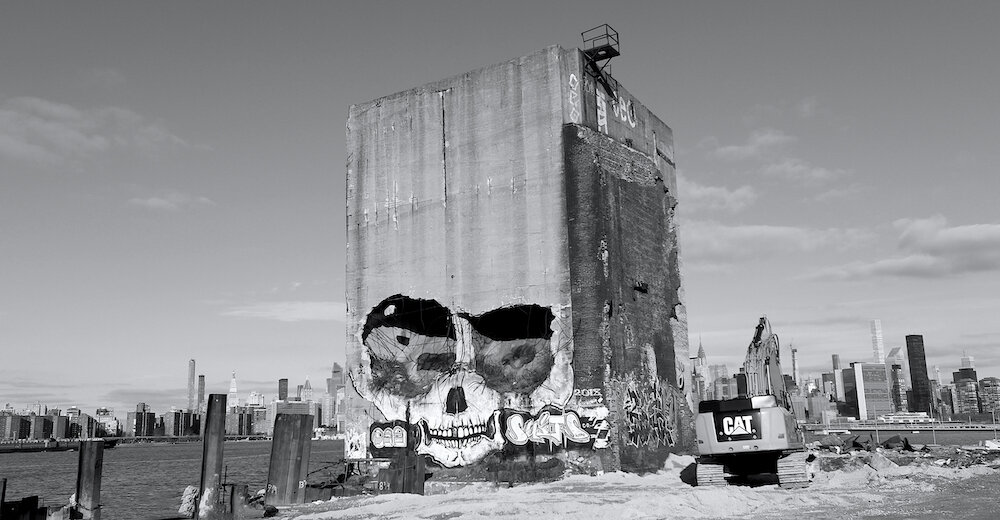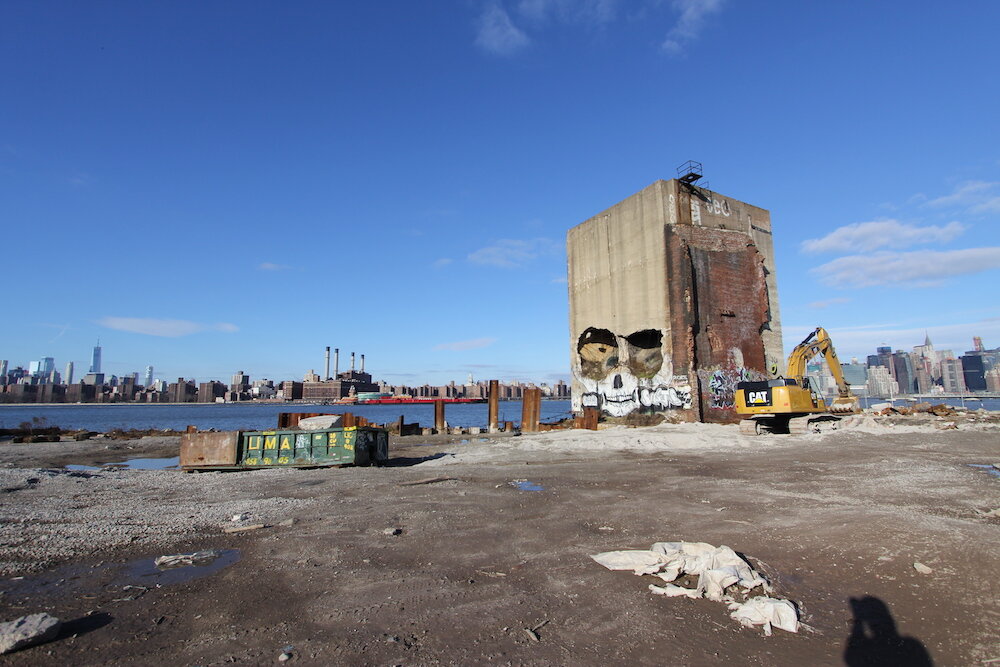Street art has been alive in New York for decades. Although the very definition of street art is as amorphous as the very structures that artists use as their canvas, the urban environment of the City serves as a breeding ground and creative stimulus for renegade creators. And although the art on Brooklyn’s skull silo popped up sometime in 2017, its story begins back in 2006 when a 10-alarm fire ripped through the Greenpoint Terminal Market, thus spawning the greatest operation by the FDNY since 9/11. The fire would rage for some 36 hours before leaving a smoldering heap of brick and a couple of ravaged buildings including a silo-like structure with two massive holes gouged from it’s south side.
2005 was a record year for the Fire Department of New York. According to the Uniformed Firefighters Association, the FDNY saw a “50% increase in ‘greater blazes’ (two alarms or more) throughout the year.” At that time, 2005 was declared as the single busiest year in the history of the FDNY with a staggering 485,702 calls answered, beating out 1977’s record of 459,567. The market blaze which gave birth to skull silo, was one of the many suspicious fires that started in Brooklyn in late 2005. From December 7, 2005 to February 2006, ten such arson-suspected fires erupted along the Pacific Street Corridor in Prospect Heights. What’s even more striking was the proximity of several of the fires: 1033, 1084, 1162, 1198, and 1140 Pacific. The other fires occurred at 530 and 600 St. Marks Avenue along with two more fires at 461 and 658 Park Place, with another at 683 Dean Street nearby. Months later, Mark Jacobson of NY Magazine so aptly stated that 2006 was very much a ‘burning season.’ The Greenpoint Terminal Market fire too had suspicious origins. And for the firefighters of Brooklyn, the true test of their experience was yet to come.
Shortly after 5:30 am on May 2, 2006, smoke began billowing from 2 Noble Street, a dilapidated brick warehouse which was part of the greater Greenpoint Terminal Market situated on the East River. Engine 238 and Ladder 106 dispatched from Greenpoint Avenue and rushed down Noble to the scene. The firefighters en route knew that that the terminal buildings had been abandoned for some time and that freeing any squatters or vagrants would be the top priority. Upon entering the warehouse, the 20 firefighters where horrified to see that the three-story structure they entered was riddled with holes in the roof and walls which were built with 19th-century heavy timber. The cavernous rooms were piled high with old bundles of rope, cotton rags from the rope making process, and leftover merchandise from back when the terminal market was a full-fledged business. It was the perfect tinderbox.
The Greenpoint Terminal Market played an important part in American industrial history at the turn of the century. The market buildings dated back to 1890 and were built by the American Manufacturing Company which happened to be the largest rope manufacturer in the United States. By the 1980s, with the buildings of the American Manufacturing Company long gone, squatters, drifters, and feral dogs and cats had occupied the space.
Courtesy of AP News
At approximately 5:44 am, a second alarm was transmitted to call for additional units to the scene. Shortly after, Engines 258, 211, 206, 207, and Ladder 128 and 119 arrived. Marine Unit 6, a 52-foot fireboat situated itself on the waterside of 2 Noble St., preparing to unleash its dual pump hoses – each capable of spraying an enfilade of 5,000 gallons of water per minute. Fifteen minutes later the fire began to spread east. For the firefighters already on the scene, the reality of the situation was clear; the building’s flammable contents and the air pouring in from its many broken windows and shoddy roof were acting as a natural accelerant. At 6:00 am, FDNY Operations Chief Sal Cassano, who would later serve as the New York City Fire Commissioner under Mayor Bloomberg, gave the order to pull out and set up for an exterior attack. A third alarm was dispatched.
Inside 2 Noble St., the conflagration became so hot that it began to generate its own wind, pushing the flames east, but also to the south, where there were more abandoned warehouses. The chiefs on scene worried that the fire might jump south across Oak Street to a new cluster of buildings. A fourth alarm brought in Engines 271, 325, 291, and 226 and Ladders 102 and 116. Units on the ground immediately opened a new front behind the building on Oak. Making its way down Oak Street was Tower Ladder 119, a 95-foot-tall apparatus with a boom and bucket capable of streaming 1,000 gallons per minute. It was looking to get as close as it could to the blaze however the towering truck encountered a second-story brick overpass that connected the main complex on Oak to the three buildings to the south. At that point, the fire was giving off such heat that a building south of Oak, ignited. By 6:30 am, the heat and spreading flames forced a fifth alarm with all units retreating back east toward West Street.
The general term “multiple-alarm fire” is a short way of indicating that a fire is severe enough to warrant additional units beyond the first dispatch. The common misconception behind multiple-alarm fires - a five-alarm fire for example - is that five firehouses responded to the call. This is not the case. Subsequent alarms beyond the first, are calls made by the chief on scene for additional units (usually an engine, ladder, or rescue truck) because the fire has become so out of control that more resources are needed to help combat it. The Greenpoint Terminal Market fire ended up dispatching 10 alarms, drawing some 80 different units from Brooklyn, Queens, and Manhattan, to the scene. In cases like this, alarms of 10 or more, requesting units from outside jurisdictions, are rare but not unheard of.
In 1995, a fire began on the ninth floor of the Clark Building, part of a complex of buildings forming the St. George Hotel in Brooklyn Heights. The initial dispatch brought the first arriving companies to an entirely different building allowing the fire to grow rapidly out of control. It would take 16 different alarms and more than 700 firefighters operating over 100 pieces of firefighting apparatuses to stop the inferno. Tangentially, the fires of the North and South Tower during the September 11th attacks were so out of control and out of reach, that they drew every available resource the FDNY could relinquish to the point where the on-scene Incident Command Post stopped counting alarms.
Around 8:15 am, while the units were retreating, 2 Noble St. collapsed, followed by nine other buildings throughout the complex. It was after the implosions that the fire finally began to settle. Officially, the inferno would not be considered under control until 5:11 pm on Wednesday, 1 day, 11 hrs and 36 minutes and some 400 firefighters later.
Upon investigation, initial attention turned to a 59-year-old Polish immigrant named Leszek Kuczera who was reportedly burning insulation off of wires for scrap metal. Kuczera, who confessed to the crime, spoke little English and was hungover the morning of his interrogation, later rescinded his confession and accepted a no-contest plea. The more damning culprit behind the Greenpoint Terminal Market fire is believed to be the owner and property developer, Joshua Guttman. Guttman had a $420 million deal to sell the complex only to see it fall through. During negotiations, the Municipal Art Society was pursuing landmark status for the entire terminal market complex. Had they succeeded, development of the Greenpoint Terminal Market would have been greatly restricted. The $420 million question was if arson had been used to quickly clear the land. Today, it is unclear what the future of the Greenpoint Terminal Market is. Like much of Brooklyn's industrial waterfront, it may soon be demolished and turned into luxury condominiums.
Today, this silo-like building at the end of Oak Street sits idly overlooking the East River. It is one of the few remaining buildings spared by the terminal market fire. On its southern facade, two massive holes are gouged from its brick and concrete structure. Sometime in 2017, a street artist named Greg Suits (@suitswon on Instagram) transformed this decaying building into a life-sized art installation by painting teeth and a jaw bone around the holes, using them as eyes. Skull silo was born!
I visited this site at the end of 2018. It’s clear that construction crews were clearing the lot for something. Despite that, the silo appeared untouched. I see the skull as an allegory to the very history and cultural significance that was lost at this site. Skull silo bears an ominous grin as if it knows the true story behind the very fire that birthed it.
Sources
Flock, E. (2013, December 31). Remembering the ‘Forgotten City,’ Greenpoint Terminal Market.
Bedford & Bowery. https://bedfordandbowery.com/2013/12/remembering-the-forgotten-city-greenpoint-terminal-market/
Hamilton, B. (2006, May 7). Fickle Wind Saved B’klyn,; Inside FDNY’s Inferno Drama
New York Post. https://nypost.com/2006/05/07/fickle-wind-saved-bklyn-inside-fdnys-inferno-drama/
Jacobson, M. (2006, September 14). Brooklyn is Burning. New York Magazine.
https://nymag.com/realestate/features/21339/
Uniformed Firefighters Association. (2006, January 31).
For the Record. https://www.ufanyc.org/cms/contents/view/3328
U.S. Fire Administration/Technical Report Series. (1995, August).
St. George Hotel Complex 16-Alarm Fire. https://www.usfa.fema.gov/downloads/pdf/publications/tr-108.pdf


